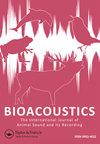生物声学指数工具:长期生物多样性监测使用传感器声学指数计算
IF 2.1
4区 生物学
Q2 ZOOLOGY
Bioacoustics-The International Journal of Animal Sound and Its Recording
Pub Date : 2021-08-16
DOI:10.1080/09524622.2021.1939786
引用次数: 0
摘要
声学指数是测量和跟踪生物多样性变化的宝贵工具。然而,由于电子学的最新发展,用于收集声学指数数据的方法可以变得更加有效。目前的过程需要在现场记录高质量的音频,并在实验室计算声学指数。这会产生大量的原始音频数据,这限制了传感器在现场花费的时间,并使数据处理和分析复杂化。此外,大多数现场录音机无法记录有助于解释短期变化的全方位环境数据。在本文中,我们介绍了生物声学指数工具,一种智能声学指数和环境传感器。生物声学索引工具在捕获音频时计算声学索引,仅存储索引信息,并记录温度、湿度和光照水平。在整个五个月的实地研究期间,传感器能够完全自主运行。在那段时间里,它记录了4000多次声学复杂性和多样性的测量,同时产生了与记录3分钟原始音频相同的数据量。这些因素使得生物声学指数工具非常适合大规模、长期的声学生物多样性监测。本文章由计算机程序翻译,如有差异,请以英文原文为准。
BioAcoustic Index Tool: long-term biodiversity monitoring using on-sensor acoustic index calculations
ABSTRACT Acoustic indices are valuable tools for measuring and tracking changes in biodiversity. However, the method used to collect acoustic index data can be made more effective by recent developments in electronics. The current process requires recording high-quality audio in the field and computing acoustic indices in the lab. This produces vast quantities of raw audio data, which limits the time that sensors can spend in the field and complicates data processing and analysis. Additionally, most field audio recorders are unable to log the full range of contextual environmental data that would help explain short-term variations. In this paper, we present the BioAcoustic Index Tool, a smart acoustic index and environmental sensor. The BioAcoustic Index Tool computes acoustic indices as audio is captured, storing only the index information, and logs temperature, humidity, and light levels. The sensor was able to operate completely autonomously for the entire five-month duration of the field study. In that time, it recorded over 4000 measurements of acoustic complexity and diversity all while producing the same amount of data that would be used to record 3 minutes of raw audio. These factors make the BioAcoustic Index Tool well-suited for large-scale, long-term acoustic biodiversity monitoring.
求助全文
通过发布文献求助,成功后即可免费获取论文全文。
去求助
来源期刊
CiteScore
4.50
自引率
0.00%
发文量
25
审稿时长
>12 weeks
期刊介绍:
Bioacoustics primarily publishes high-quality original research papers and reviews on sound communication in birds, mammals, amphibians, reptiles, fish, insects and other invertebrates, including the following topics :
-Communication and related behaviour-
Sound production-
Hearing-
Ontogeny and learning-
Bioacoustics in taxonomy and systematics-
Impacts of noise-
Bioacoustics in environmental monitoring-
Identification techniques and applications-
Recording and analysis-
Equipment and techniques-
Ultrasound and infrasound-
Underwater sound-
Bioacoustical sound structures, patterns, variation and repertoires

 求助内容:
求助内容: 应助结果提醒方式:
应助结果提醒方式:


